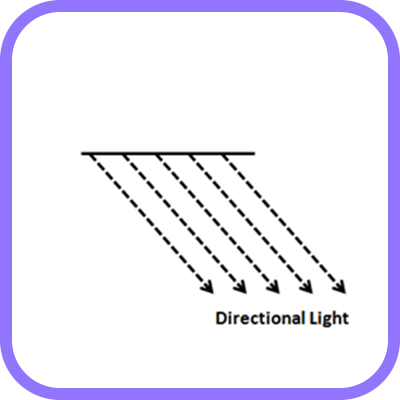Directional Light
A Directional Light is a type of light source that emits light in a specific direction, similar to sunlight. It is commonly used to simulate the sun's light in outdoor scenes and provides a consistent light source that illuminates the entire scene uniformly. In this guide, you will learn how to create and configure a Directional Light in Unity to illuminate your scene effectively.

Creating a Directional Light
To create a Directional Light in Unity, follow these steps:
- Open the Unity Editor and create a new scene or open an existing scene.
- Go to
GameObject > Light > Directional Lightin the Unity Editor's menu bar. - A Directional Light object will be created in your scene, emitting light in the direction of the positive Z-axis by default.
Configuring a Directional Light
Once you have created a Directional Light in your scene, you can configure its properties to achieve the desired lighting effects. Some of the key properties of a Directional Light that you can adjust include:
-
General Settings:
- Type: Specifies the type of light source (Directional Light).
- Mode: Determines how the light interacts with objects in the scene (Realtime or Baked).
-
Emission:
- Color: Specifies the color of the light emitted by the Directional Light.
- Intensity: Controls the brightness of the light.
- Indirect Multiplier: Adjusts the intensity of indirect lighting contributions.
- Cookie: Allows you to add a texture to simulate shadows or light patterns.
-
Rendering:
- Render Mode: Determines how the light is rendered (Auto, Important, or Not Important).
- Culling Mask: Specifies which layers the light affects.
-
Shadows:
- Shadow Type: Specifies the type of shadows cast by the light (Hard Shadows, Soft Shadows, or No Shadows).
By adjusting these properties, you can customize the appearance and behavior of the Directional Light in your scene. Experiment with different settings to achieve the desired lighting effects and create visually stunning scenes.
Using Directional Light in Your Scene
A Directional Light is commonly used to simulate sunlight in outdoor scenes. By positioning the Directional Light at an angle above the scene, you can create realistic lighting effects that enhance the mood and atmosphere of the environment. You can also adjust the color, intensity, and other properties of the Directional Light to achieve different lighting effects and create visually appealing scenes.
In addition to simulating sunlight, a Directional Light can also be used to create stylized lighting effects, such as silhouettes, rim lighting, and dramatic shadows. Experiment with different configurations and settings to achieve the desired look and feel for your project.
Directional Light Positioning Tips
When positioning a Directional Light in your scene, consider the following tips:
-
Angle: Position the Directional Light at an angle above the scene to simulate sunlight. Experiment with different angles to achieve the desired lighting effects.
-
Rotation: Rotate the Directional Light to adjust the direction of the light. This can affect the shadows and highlights in your scene.
-
Color: Adjust the color of the Directional Light to create different lighting effects. For example, warm colors like orange and red can simulate a sunset, while cool colors like blue can create a moonlit effect.
-
Intensity: Control the intensity of the Directional Light to adjust the brightness of the light. Higher intensities create brighter lighting effects, while lower intensities create softer lighting.
By following these tips and experimenting with different configurations, you can effectively use a Directional Light to illuminate your scene and create visually stunning environments in Unity.
Conclusion
A Directional Light is a powerful tool for illuminating your scene and creating visually stunning environments in Unity. By adjusting the properties and configurations of the Directional Light, you can achieve different lighting effects and enhance the mood and atmosphere of your project. Experiment with different settings and configurations to create realistic lighting effects, stylized lighting, and visually appealing scenes that captivate your audience.
Updated over 1 year ago